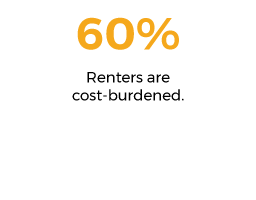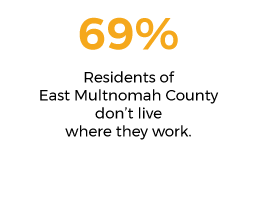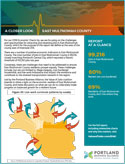a closer look: East multnomah county
Report Home // Portland’s Story // East Multnomah County // Prosperity & Productivity // Opportunity & Affordability // Workforce & Investment Climate // Why This Matters
For the 2018 Economic Check-Up we took a closer look at the challenges and opportunities for attracting and retaining jobs in East Multnomah County, which is defined as the area of the county east of Interstate 205 for the purpose of this report.
There are a number of positive economic indicators in this area of the region. The total number of jobs in East Multnomah County is 99,216, closely matching Portland’s Central City, which reported a historic threshold of 102,361 jobs in 2017.
Conversely, there are challenges that need to be addressed to ensure East Multnomah County residents prosper equally with the rest of the region. These challenges include, but are not limited to: wage inequity; cost-burdened households; and live-work imbalance that impact the workforce and contribute to the strained transportation network in the region.
Led by the Portland Business Alliance, the Value of Jobs coalition intends to shine a light on the economic realities of East Multnomah County and invite discussion on what we can do to collectively make progress on balanced growth for a resilient future.
East Multnomah County Executive Summary (pdf)
east multnomah county report at a glance



An analysis of commute patterns found that the majority of residents who live in East Multnomah County don’t work there. Conversely, the majority who work in East Multnomah County, don’t live there. East Multnomah County only employs an estimated 31 percent of Multnomah County residents. More workers commute into East Multnomah County (67 percent) than the rest of the county (44 percent). See Figure 30. As a result, there is a high share of workers commuting in and out of the area, which has adverse environmental impacts and strains an infrastructure system that is overdue for significant investment.
Homeowners living in East Multnomah County are more likely to have housing that is affordable based on their income levels than homeowners across the region. This is not the case for renters. Almost 60 percent of renters are cost-burdened in East Multnomah County.
Economic disparities also exist at income levels across all industries in East Multnomah County. Virtually all industry sectors have lower average wages than the rest of the region. Of the few industries with higher wages, only a small number of workers are employed. The exception is retail, which employs roughly 13,500 workers who earn, on average, $1,500 more a year. See Figure 31.
In the health care and manufacturing industries, average wages are lower by roughly $10,000 and $24,000, respectively. The discrepancy in health care is due to the fact that jobs in East Multnomah County are more likely to be in smaller clinics or rehabilitation services, where wages are lower than at larger hospitals west of I-205. In addition to the average wage of manufacturing jobs being significantly less than the rest of the region, there are fewer jobs in East Multnomah County, perhaps due to the high concentration of manufacturing growth west of the Willamette River, particularly in Washington County. On the higher end, the utilities industry has the highest average wage in East Multnomah County, although this industry represents a small share of employment within the area.
As our 2018 Economic Check-Up illustrates, wage disparities by race exist across households in our region. Keeping this in mind, it’s important to note that the population east of I-205 has also become more diverse in the last five years. People of color living in East Multnomah County increased by 15 percent, compared to the rest of Multnomah County, which saw a 13 percent increase. See Figure 5.
why this matters
Together, these statistics illuminate the tremendous assets, challenges and opportunities in East Multnomah County. Long overdue for meaningful public and private collaboration, we must look at East Multnomah County’s needs to more equitably retain and attract family-wage jobs, so those who live there are able to access opportunities similarly to residents in the rest of the region.

